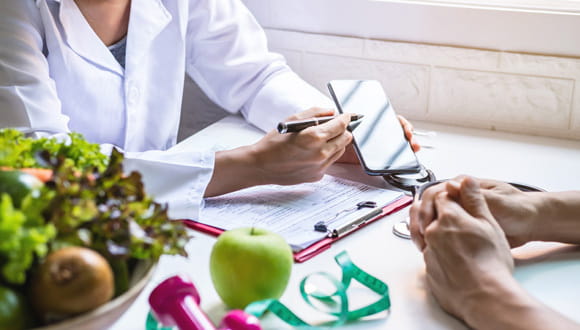Diabetes Diet Plan: What Are the Foods to Avoid With Diabetes?
Nov. 8, 2021 - Katie McCallumType 2 diabetes is a complex condition. There's no single thing that causes it, and there's no simple solution to fixing it either.
One thing we know for sure, though, is that diabetes and your diet are intimately linked. All foods impact our blood sugar, even if only a little bit.
But if you have diabetes, what you eat can have huge implications on your blood sugar levels. This can make knowing what to eat stressful and confusing. Let's cut through the noise by learning the nutrition goals for diabetics and some practical tips on the best things to eat.
"Since a person with diabetes is more prone to experiencing blood sugar highs, the goal of diabetes nutrition therapy is to help give you better control of your blood sugar," says Amanda Beaver, wellness dietitian at Houston Methodist. "Choosing foods that keep your blood sugar in a safer range, as well as avoiding the ones that don't, helps reduce your risk of your condition progressing and developing complications."
So which foods are fine to eat freely, and which should you avoid? Here's what to know if you're trying to adjust your diet so you can better manage diabetes.
How many carbs should you have per day in a diabetes diet plan?
Carbohydrates are probably the most talked about nutrient when it comes to diabetes, since both certain carbs and large amounts of any carbs can easily take your blood sugar beyond the target range.
"When living with diabetes, a person's carbohydrate needs vary depending on a lot of factors, such as age and activity level," recommends Beaver. "The best thing to do is to work with a registered dietitian to figure out how many carbs per meal are best for you."
That said, here are general carbohydrate recommendations for optimal blood sugar control:
- Women: About 45 grams of carbs per meal
- Men: About 60 grams of carbs per meal
- 15-20 grams of carbs at a snack
"It's best to spread your carb intake evenly throughout the day, rather than having most of your allotted carbs at one meal since this can lead to a big blood sugar spike that is tough to get back down," says Beaver.
It's also important to know that not all carbs are created equal.
"The simple carbs in a pop tart, for example, are absorbed quickly, causing a spike in your blood sugar," explains Beaver. "The complex carbs in other foods — beans, for instance — are absorbed more slowly, allowing blood sugar to rise more gently and making us feel fuller for longer."
The simple carbs to limit include highly processed foods and snacks, such as:
- Chips
- Crackers
- Cookies
- Pastries
- Snack bars
The less processed carbs that are better options include:
- Fresh fruit
- Beans and lentils
- Whole grains, such as whole wheat breads and pastas, oatmeal, quinoa and brown rice
"A common misconception about living with diabetes is that you should avoid eating fruit, because of the sugar content," says Beaver. "But this isn't actually the case. Some studies have shown that people who have diabetes who eat fruit tend to have better controlled blood sugar than those with diabetes who have little to no fruit."
Are there fruits to avoid with diabetes?
"When it comes to fruit, it is all about balance," explains Beaver. "If you're having it as a part of a balanced meal or having a healthy portion size as a snack, eating fruit isn't a problem. When it becomes an issue is if you're having just fruit for a meal or eating a very large amount of it."
Fruit is actually lower in carbs than many common snack foods — not to mention packed with other beneficial nutrients like fiber, vitamins and minerals — making it a better snack option.
Still, some fruits have more sugar than others, so lower-sugar fruits may make meeting blood sugar goals easier.
Lower-sugar fruits include:
- Watermelon (yes, watermelon! — it's mostly water)
- Strawberries
- Mandarin oranges
- Blackberries
- Peaches
- Cantaloupe
- Honeydew
- Raspberries
Higher-sugar fruits include:
- Grapes
- Bananas
- Mangos
- Large apples
"This doesn't mean you can't eat these higher-sugar fruits, just be mindful of how much you have," adds Beaver.
What are the best foods for diabetes control?
"The best foods to eat regularly for blood sugar control are ones rich in fiber and protein, along with some fruit and plenty of colorful veggies," says Beaver.
Healthy options to consider when thinking about diabetes meal planning include:
- Leafy greens, including spinach, collard greens, spring mix and cabbage
- Broccoli, carrots and cauliflower
- Beans and whole grains, including chickpeas, peas, red lentils, oatmeal, quinoa and brown rice
- Proteins such as tuna, salmon, chicken (white and dark meat) and Greek yogurt (look for brands that have less than 10 grams of added sugar)
- Nuts and seeds, including walnuts, cashews, peanuts, almonds and pumpkin seeds
"Overall, the best way to control your blood sugar is to have balanced meals," says Beaver. "This means having a good protein source at every meal — even breakfast! — and including some type of vegetable with both lunch and dinner. It also means choosing healthy snacks between meals — of which nuts are a great choice since they're packed with nutrition and very low in carbohydrates."








